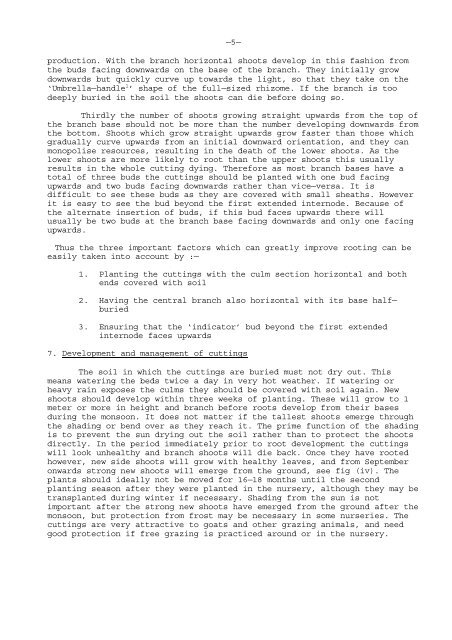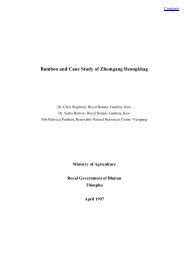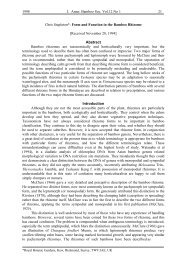Propagation of Bambusa & Dendrocalamus species by culm cuttings
Propagation of Bambusa & Dendrocalamus species by culm cuttings
Propagation of Bambusa & Dendrocalamus species by culm cuttings
Create successful ePaper yourself
Turn your PDF publications into a flip-book with our unique Google optimized e-Paper software.
—5—<br />
production. With the branch horizontal shoots develop in this fashion from<br />
the buds facing downwards on the base <strong>of</strong> the branch. They initially grow<br />
downwards but quickly curve up towards the light, so that they take on the<br />
‘Umbrella—handle 1 ’ shape <strong>of</strong> the full—sized rhizome. If the branch is too<br />
deeply buried in the soil the shoots can die before doing so.<br />
Thirdly the number <strong>of</strong> shoots growing straight upwards from the top <strong>of</strong><br />
the branch base should not be more than the number developing downwards from<br />
the bottom. Shoots which grow straight upwards grow faster than those which<br />
gradually curve upwards from an initial downward orientation, and they can<br />
monopolise resources, resulting in the death <strong>of</strong> the lower shoots. As the<br />
lower shoots are more likely to root than the upper shoots this usually<br />
results in the whole cutting dying. Therefore as most branch bases have a<br />
total <strong>of</strong> three buds the <strong>cuttings</strong> should be planted with one bud facing<br />
upwards and two buds facing downwards rather than vice—versa. It is<br />
difficult to see these buds as they are covered with small sheaths. However<br />
it is easy to see the bud beyond the first extended internode. Because <strong>of</strong><br />
the alternate insertion <strong>of</strong> buds, if this bud faces upwards there will<br />
usually be two buds at the branch base facing downwards and only one facing<br />
upwards.<br />
Thus the three important factors which can greatly improve rooting can be<br />
easily taken into account <strong>by</strong> :—<br />
1. Planting the <strong>cuttings</strong> with the <strong>culm</strong> section horizontal and both<br />
ends covered with soil<br />
2. Having the central branch also horizontal with its base half—<br />
buried<br />
3. Ensuring that the ‘indicator’ bud beyond the first extended<br />
internode faces upwards<br />
7. Development and management <strong>of</strong> <strong>cuttings</strong><br />
The soil in which the <strong>cuttings</strong> are buried must not dry out. This<br />
means watering the beds twice a day in very hot weather. If watering or<br />
heavy rain exposes the <strong>culm</strong>s they should be covered with soil again. New<br />
shoots should develop within three weeks <strong>of</strong> planting. These will grow to 1<br />
meter or more in height and branch before roots develop from their bases<br />
during the monsoon. It does not matter if the tallest shoots emerge through<br />
the shading or bend over as they reach it. The prime function <strong>of</strong> the shading<br />
is to prevent the sun drying out the soil rather than to protect the shoots<br />
directly. In the period immediately prior to root development the <strong>cuttings</strong><br />
will look unhealthy and branch shoots will die back. Once they have rooted<br />
however, new side shoots will grow with healthy leaves, and from September<br />
onwards strong new shoots will emerge from the ground, see fig (iv). The<br />
plants should ideally not be moved for 16—18 months until the second<br />
planting season after they were planted in the nursery, although they may be<br />
transplanted during winter if necessary. Shading from the sun is not<br />
important after the strong new shoots have emerged from the ground after the<br />
monsoon, but protection from frost may be necessary in some nurseries. The<br />
<strong>cuttings</strong> are very attractive to goats and other grazing animals, and need<br />
good protection if free grazing is practiced around or in the nursery.





